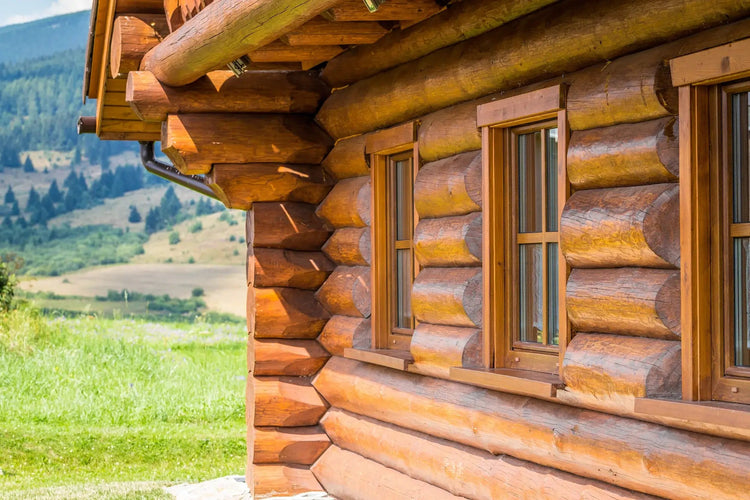Proper substrate preparation and application are imperative for product longevity.
Read this entire label and the Data Tec sheet, before applying any product.
Please do not hesitate to contact us with any Log Jam Chinking Application questions (888) 307-3327.
Weather Conditions
1. Best results are obtained when Log Jam Chinking is applied to clean, dry, stained wood. Make certain there is compatibility between your stain and Log Jam. Call Western Log Home Supply for guidance if in doubt.
2. Check the weather forecast. Finishing products are best applied in moderate weather conditions, i.e., out of direct sunlight, dry conditions and warm.
3. Check the log surface temperature. The ideal application range is between 50-90°F.
4. Install a bond breaker, either backer board or backer rod, depending on the style of log, to provide 2-point adhesion. We do not recommend the use of blue or pink styrene board.
5. If backer board is being used, tape the entire joint with either mylar or duct tape.
6. Gun the chinking over the backing material. Ideal sealant depth is 1/2 of the joint width, but no less than 1/4”, nor more than 1/2”.
7. Tool Log Jam Chinking to ensure good contact with the log surfaces, especially to the upper log; this will greatly aid adhesion.
8. All chinking products may occasionally “blister”.
To avoid blistering:
- Do not apply in direct sunlight.
- Protect from direct sunlight for 1-2 days after
application with white plastic sheeting tacked over the fresh chinking.
Surface Preparation
- Best results are obtained when Log Jam is applied to wood that has been previously coated with a compatible stain. If newly stained, the stain should be thoroughly cured before Log Jam application. If the stain is older but still intact, clean the log surfaces thoroughly to remove dirt, pollen, bird droppings and other surface contaminants.
- The USDA Forest Products Laboratory and other researchers around the world have recently reported that surface wood exposed to sunlight for as little as 1-2 weeks can become significantly damaged and unsound which may lead to premature adhesive failure of coatings. Such surface wood damage has the potential to, also, harm adhesion. So, once bare wood has been properly cleaned and prepped to remove unsound wood, Log Jam should always be applied as soon as possible.
- Some coatings that contain high levels of wax must only be applied after Log Jam has been applied and allowed to cure. Additionally, coatings that are based on non-drying oils, like motor oil, should never be used in combination with Log Jam—neither before nor afterwards— since such oils can migrate to the bondline and destroy adhesion. We maintain a list of some of the treatments, which should be applied after applying Log Jam, making sure Log Jam is thoroughly cured.
- Sashco can also test the compatibility of stains. Please allow a minimum of 6 weeks for testing. Call Sashco for more information. If a stain is applied over Log Jam, it will be tinted the stain color, but will be affected differently than the surrounding wood. Test appearance before widespread use.
Methods of Application
- When using 5-gallon pails, use the patented Snorkler Pumping system, grout bags or bulk loading guns may be used. Although Log Jam is freeze-thaw stable, it will dispense easier when it is kept warm before use.
When using a cartridge, cut the spout at a 45° angle to desired bead size. In wider joints, multiple beads may need to be run until the entire joint is filled with chinking.
- Round Logs: To use a foam brush, work the material smooth with a damp brush, keeping a rag handy to pick up drips of water and excess Log Jam.
- Square Logs: Use a putty knife to strike off excess of Log Jam, making the joint level with the logs. Use a damp foam brush to smooth the material, keeping a rag handy to absorb drips and wipe off excess Log Jam.
Not only do these techniques give an aesthetically pleasing chinking line, they also ensure a proper seal between the Log jam and the log surface.
Applying Log Jam to Slab Siding
Slab siding can pose a special challenge due to the very rapid and large amount of movement it often exhibits after being installed. This movement shows up as extreme shrinkage, bowing and twisting, and can stress sealants more than logs do. To best help reduce this problem, the slab siding should be installed with heavy screws, rather than with nails. Use dry slab siding, and verify moisture level with a moisture meter.
1. Start with clean wood that has already been treated with a preservative and stain compatible with Log Jam. We recommend Timbor as a preservative and either
Capture/Cascade or Transformation Log Stain. The coated wood should also be well cleaned immediately before the Log Jam is applied.
2. It used to be possible to apply chinking directly to Tyvek™ house-wrap, but with recent changes made to this house-wrap product, this is no longer true. So, mylar or duct tape should be applied to wrinkle-free Tyvek™ wrap before Log Jam is applied. Wrinkles left in the wrap will “telegraph” or show through.
3. If the boards are thick enough to install backer rod, we recommend using it.
4. Apply Log Jam Chinking by use of trowel, grout bag, bulk loading gun, pre-loaded cartridges, or commercial machinery, such as the patented Snorkler Pump.
5. The width of the contact surface of the Log Jam on the edges of the siding should not be less than 3/8" (to insure good adhesion) — and the Log Jam should be firmly tooled for good contact with the top and bottom siding boards.
6. Don’t forget to chink or caulk (with Log Jam, Log Builder or Conceal) the butt joints where moisture could otherwise gain entry in driving rains.
NOTE: Ideal joint design allows for the chinking to form an hour glass shape, as in this drawing, with the half rod backer material. Some slab siding undergoes extreme shrinkage which can lead to some early-on maintenance of the chinking.
Clean-up and Disposal
- Dispose of Log Jam in accordance with local regulations. Do not dispose of in drinking water supplies.
- Hands, surfaces and equipment may be cleaned-up with water.
Warning: Blisters May Occur
- Blisters are a phenomenon commonly found in the caulking and sealant industry. They form when moisture from the chinking accumulates in voids beneath the bead and gets hot from the sun. Blisters appear as “bubbles” in the material and vary widely in size.
- Shield freshly chinked walls from the sun with white tarps. If this cannot be done, keep a close eye on the chinked wall for the first 24-48 hours. If a blister begins to develop, puncture a hole in the middle of it, and gently push the material back into place. 3-5 days later, touch-up the repaired blister with Log Jam Chinking.


